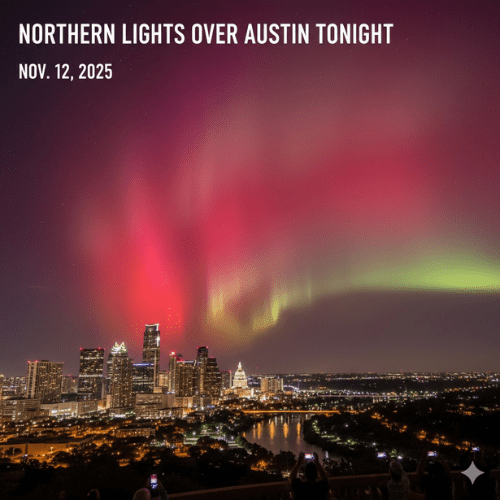✨Austin Sky Alert: Northern Lights Set for a Rare Appearance

Get ready for an incredible sight! The Northern Lights—also known as the Aurora Borealis—are expected to be visible in the Austin area tonight, Wednesday, November 12, 2025. This is a chance to see a natural light show usually reserved for much colder, more northern places.
What’s Causing This Rare Texas Show?
The display is all thanks to a huge event that took place on the Sun.
- Solar Eruptions: The Sun has recently ejected massive clouds of super-hot, charged particles and magnetic fields. Scientists call these events Coronal Mass Ejections (CMEs).
- The Big Impact: These fast-moving particles have traveled through space and are now striking Earth’s magnetic field.
- A Severe Storm: This collision creates an intense space weather event known as a geomagnetic storm. When the storm is powerful enough—like the current one. Which is rated G4 or “Severe”—it pushes the glowing aurora display farther from the poles and closer to the equator. Making it visible even in Central Texas.
- The Colors: These solar particles produce the beautiful light when they hit gases high up in our atmosphere. You’ll likely see pinks and deep reds this far south, which are caused by the particles interacting with oxygen at higher altitudes.
Key Tips to Catch the Northern Lights Tonight
The aurora will be faint in the Austin metro area because of city light pollution, so follow these simple steps to boost your chances of seeing it:
| Viewing Action | Why It Matters |
| Go Rural and Dark | The best views will be in the Texas Hill Country or any location outside the bright city lights. Light pollution drowns out the show. |
| Look North | The lights will appear low on the northern horizon. Find a spot with an unobstructed, clear view in that direction. |
| Check Late at Night | The most intense part of the storm often happens after sunset and lasts late into the night. Aim to look up after 10:00 PM local time. |
| Use Your Smartphone Camera | Cameras are much better at picking up the faint colors than the human eye. Use your phone’s Night Mode or a long exposure setting to take a picture of the northern sky. |
Why is the Sun So Active Right Now?
This incredible event isn’t just a random occurrence. The Sun is currently nearing the maximum point of its 11-year activity cycle, which scientists call Solar Maximum.
This is the time when solar flares and CMEs are most frequent. Making strong geomagnetic storms and rare, widespread aurora displays are much more common than usual. This is an exciting period for sky watchers across the country!
This is a fleeting and exceptional event for Texans. Don’t forget to look up tonight!
Read More Articles Click Here. Read Previous Article Click Here.



